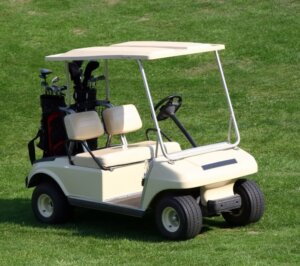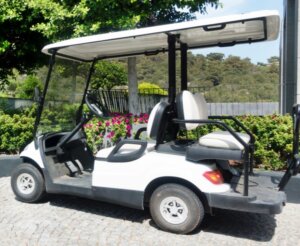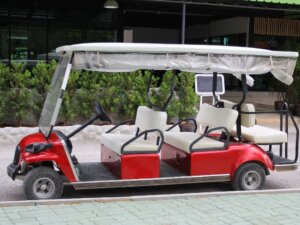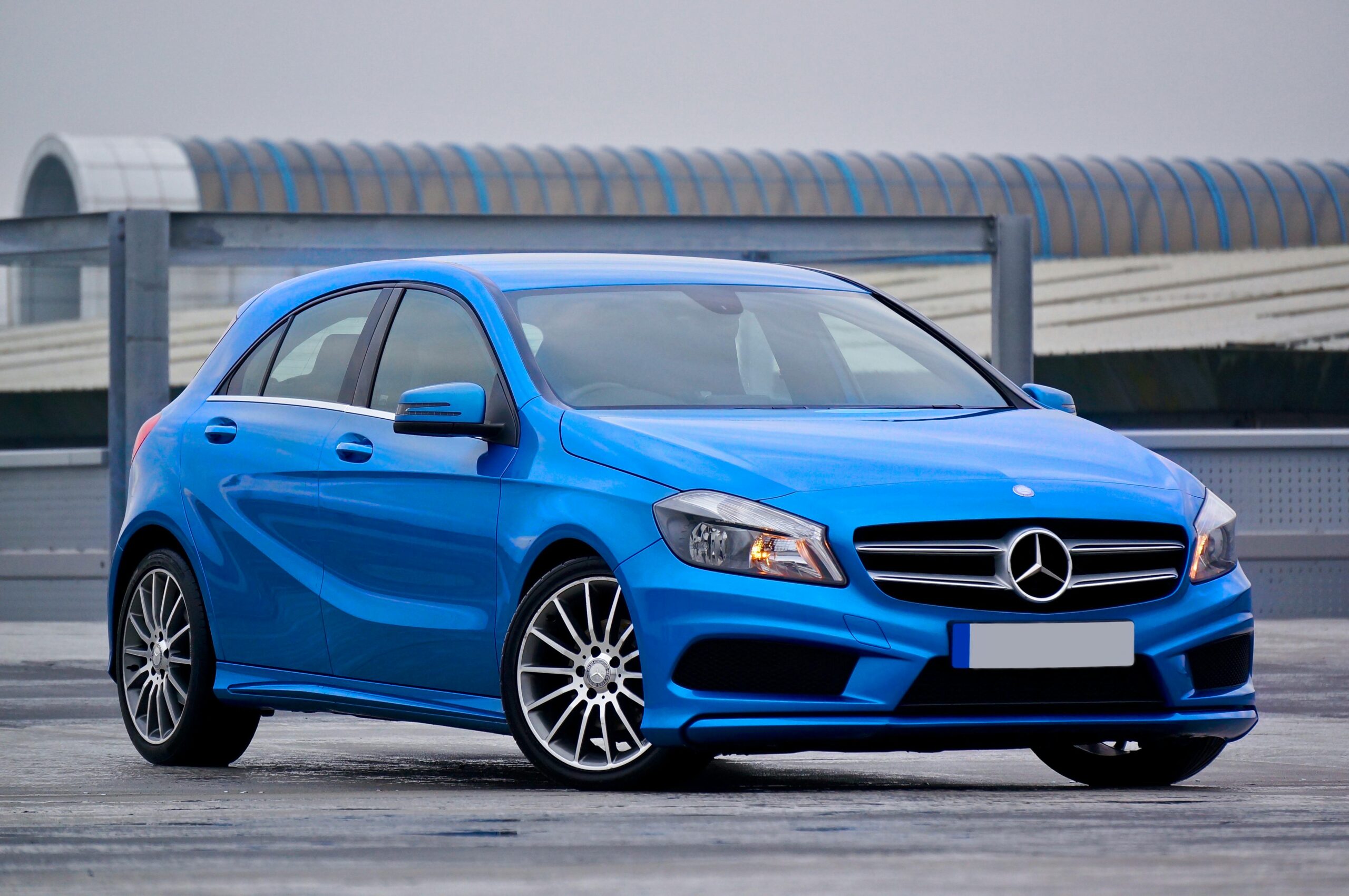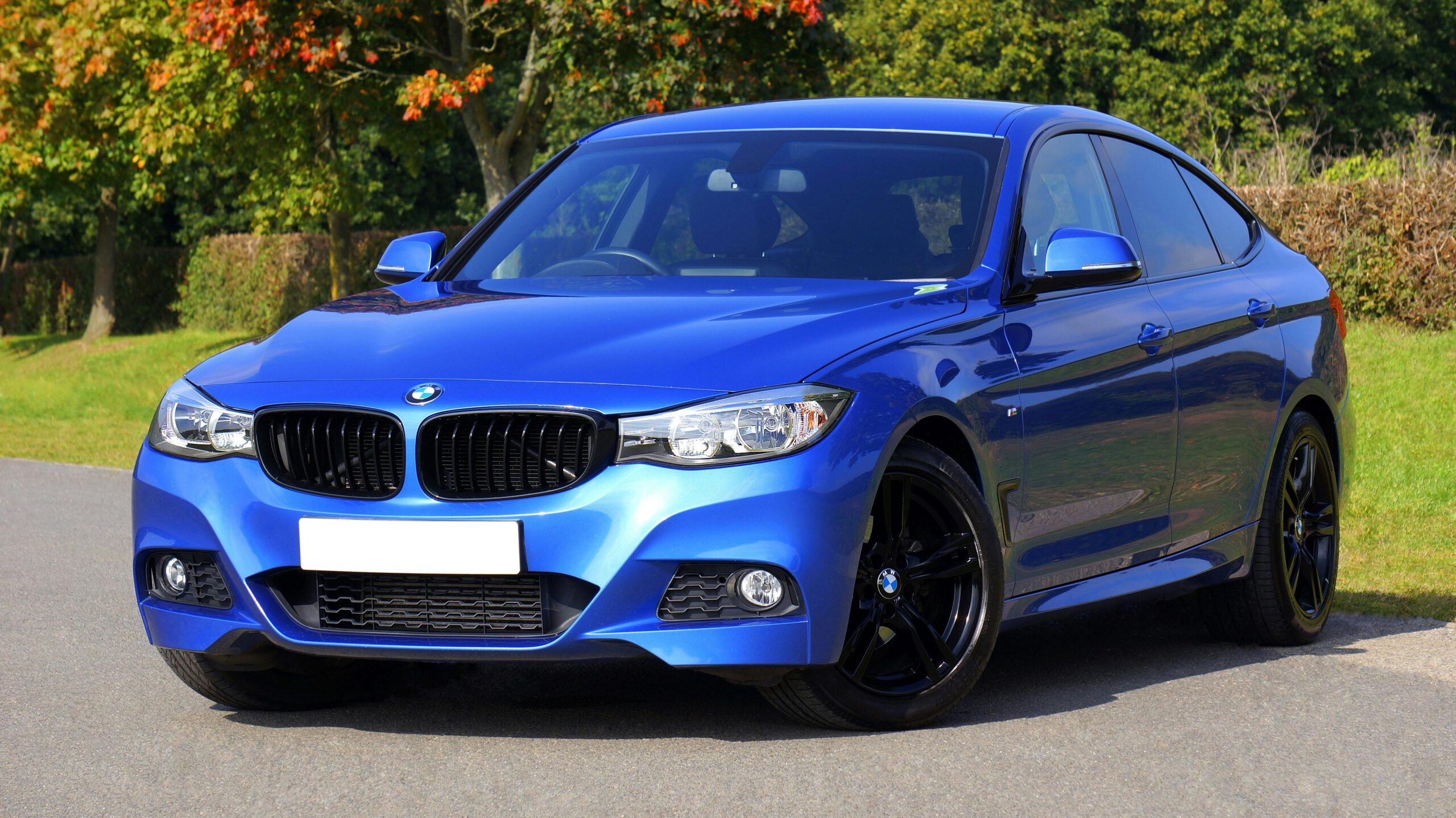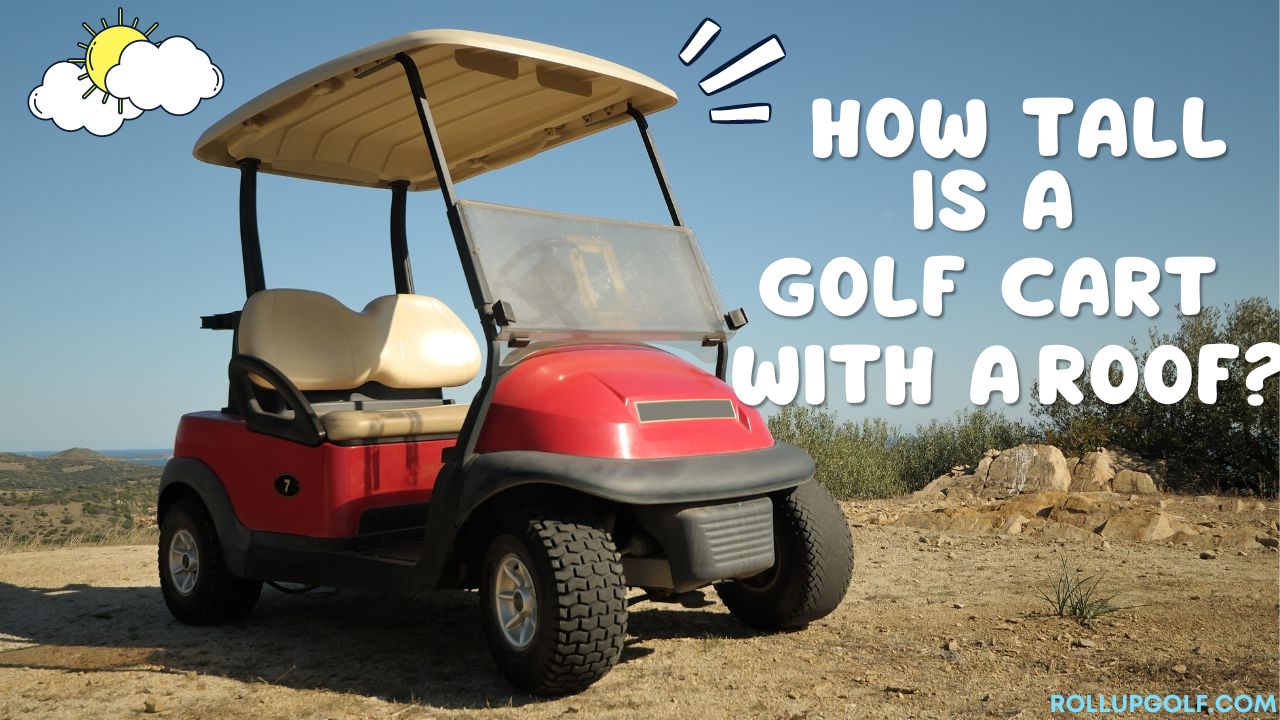
Golf carts, ubiquitous on golf courses and increasingly used for various transportation needs, come in different shapes and sizes. One pertinent question that often arises is, “How tall is a golf cart with a roof?” Understanding the height of a golf cart with a roof is crucial for several reasons, including safety, maneuverability, and compliance with regulations.
Read also: How wide is a golf cart? – 2024
How Tall is a Golf Cart with a Roof?
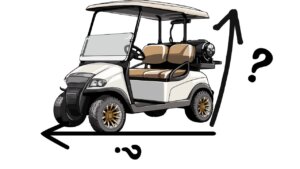
The height of a golf cart with a roof can vary depending on several factors, including:
- Roof style: Different roof styles, like high-tops, standard roofs, and lifted roofs, have different heights.
- Golf cart model: Different models might have slightly different base heights, affecting the overall height of a roof.
- Manufacturer: Manufacturers may have slight variations in design.
Here’s a general overview:
- Average 2-seater golf cart with a standard roof: Around 6.25 feet (75 inches) tall.
- Average 2-seater golf cart with a high-top roof: Can range from 7.5 to 8.5 feet (88-102 inches).
- Large 4-seater golf cart with a standard roof: Around 6.5-7 feet (78-84 inches) tall.
- Lifted golf carts: Can increase the total height by 4-8 inches depending on the lift kit.
Remember, these are just estimates. For the most accurate information, always check the manufacturer’s specifications for the specific model and roof type you’re interested in.
Here are some resources to help you find the exact height:
- Manufacturer’s website: You can usually find detailed specifications on the manufacturer’s website.
- Online stores: Many online stores selling golf carts will list the dimensions in the product description.
- Dealerships: Local dealerships can also provide you with the exact dimensions of a specific model with a roof.
golf cart dimensions
| Seater capacity | Length (ft) | Width (ft) | Height (ft) | |
|---|---|---|---|---|
| 2
|
8.0 | 4.0 | 6.25 | |
| 4
|
9.5 | 4.5 | 6.50 | |
| 6
|
10.0 | 5.0 | 6.75 |
How many feet is a golf cart?
A golf cart’s length can vary depending on the specific model and size, but here’s a breakdown:
- Average 2-seater golf cart: This is the most common type, and it’s typically around 8 feet long, or 6.25 feet excluding the wheels.
- Larger golf carts: These can seat 4-6 people and are longer, ranging from 9.5 to 11.5 feet long.
So, a golf cart can be anywhere from 6.25 to 11.5 feet long, expressed in feet.
It’s important to note that these are just general ranges, and the specific dimensions of any individual golf cart may vary. If you’re interested in the exact size of a particular model, you can always check the manufacturer’s specifications.
Standard Height of Golf Carts
Golf carts typically come in standard dimensions to accommodate various users comfortably. While the dimensions may vary slightly between manufacturers and models, the standard height of a golf cart without any modifications usually falls within a certain range.
Read also: What Is an Eagle in Golf? Explained
Height of Golf Cart with Roof
The addition of a roof to a golf cart alters its overall height. Several factors contribute to the height of a golf cart with a roof, including the design of the roof itself and any additional accessories installed. On average, a golf cart with a roof can range from approximately 60 inches to 80 inches in height, depending on these factors.
How heavy is a golf cart?
The weight of a golf cart can vary quite a bit depending on several factors, but here’s a breakdown:
Typical range:
- 800 to 1,100 pounds (363 to 499 kg) is the average weight range for most golf carts.
Factors affecting weight:
- Fuel vs. electric: Electric golf carts are generally lighter, with an average weight range of 700-900 pounds (318-408 kg), while gas-powered ones are heavier, typically weighing around 900-1,100 pounds (408-499 kg) due to the fuel tank and engine.
- Size and number of seats: Larger carts with more seats tend to be heavier. A small 2-seater might weigh around 500 pounds (227 kg), while a large 6-seater can reach 1,300 pounds (590 kg).
- Brand and model: Different manufacturers and models have their own weight variations.
- Accessories: Additional features like roofs, lifted suspensions, and cargo boxes add weight.
Examples:
- Club Car Precedent: 909 pounds (412 kg)
- EZGO TXT: 870 pounds (395 kg)
- Yamaha Drive2: 780 pounds (354 kg)
Keep in mind:
- These are just general ranges, and the specific weight of any individual golf cart may vary.
- Always check the manufacturer’s specifications for the exact weight of the model you’re interested in.
I hope this information helps!
Importance of Roof Height
Understanding the height of a golf cart with a roof is essential for various reasons. Firstly, it impacts the safety of passengers, particularly regarding headroom and clearance. A roof that is too low may pose a risk of head injuries, especially in the event of sudden stops or bumps on uneven terrain.
Moreover, the height of the roof also affects the cart’s maneuverability, especially when navigating through areas with low-hanging branches or structures. It’s crucial to ensure that the height of the golf cart with the roof allows for safe passage without risking damage to the cart or potential injury to passengers.
Types of Golf Cart Roofs

Golf cart roofs come in various styles, each offering unique features and benefits to users. Understanding the different types of golf cart roofs can help you choose the one that best suits your needs and preferences.
1. Standard Roof
The standard roof is the most common type found on golf carts. It typically consists of a simple canopy or cover that provides basic protection from the sun and light rain. Standard roofs are lightweight and affordable, making them a popular choice for golfers and recreational users.
2. Extended Roof
Extended roofs offer additional coverage compared to standard roofs. They are designed to provide more shade and protection from the elements, making them ideal for users who spend extended periods outdoors or frequently use their golf carts in inclement weather. Extended roofs often have a larger surface area and may extend further over the front and rear of the cart.
3. Convertible Roof
Convertible roofs offer the ultimate versatility, allowing users to adjust the roof to suit their needs. These roofs typically feature panels or sections that can be opened or closed depending on the weather conditions. Convertible roofs provide the flexibility to enjoy open-air driving on sunny days or quickly close the roof to shield passengers from rain or harsh sunlight.
4. Hardtop Roof
Hardtop roofs are constructed from durable materials such as fiberglass or plastic and provide superior protection from the elements. Unlike fabric or canvas roofs, hardtop roofs are rigid and offer enhanced durability and resistance to wear and tear. They are ideal for users who require maximum protection and durability from their golf cart roof.
5. Sunbrella Roof
Sunbrella roofs are made from high-quality fabric that offers excellent UV protection and resistance to fading. These roofs are lightweight, breathable, and easy to clean, making them a popular choice for users who prioritize sun protection and comfort. Sunbrella roofs are available in a variety of colors and patterns to suit individual style preferences.
6. Custom Roof
For users with specific requirements or preferences, custom roofs offer the opportunity to design a roof tailored to their exact specifications. Custom roofs can be constructed from a variety of materials and can incorporate additional features such as built-in lighting, speakers, or storage compartments. While custom roofs may be more expensive than standard options, they provide the ultimate in customization and personalization.
7. Solar-Powered Roof
Solar-powered roofs are equipped with photovoltaic panels that harness solar energy to power the golf cart’s electrical system. These roofs are environmentally friendly and can help reduce energy costs by supplementing the cart’s battery power. Solar-powered roofs are an innovative option for eco-conscious users looking to reduce their carbon footprint.
8. Folding Roof
Folding roofs feature hinged panels or sections that can be folded down when not in use, allowing for easy storage and transportation. These roofs offer the convenience of a compact design while still providing protection from the elements when needed. Folding roofs are popular among users who require a versatile and space-saving solution for their golf cart roof.
Read also: Golf ball
Regulations and Standards
In many areas, there are regulations and standards in place regarding the dimensions of golf carts, including height restrictions. These regulations are designed to ensure the safety of passengers and pedestrians and may dictate maximum height limits for golf carts used in specific settings, such as public roads or pedestrian pathways.
Modifying Roof Height
Modifying the height of a golf cart’s roof is possible and can be done for various reasons, including accommodating taller passengers, improving aesthetics, or complying with specific regulations. Before undertaking any modifications, it’s essential to consider the implications and ensure that the changes align with safety standards and regulations.
1. Roof Raising Kits
One common method of increasing the height of a golf cart’s roof is by installing a roof-raising kit. These kits typically include extensions or spacers that are added between the roof and the cart’s frame, effectively raising the overall height of the roof. Roof raising kits are relatively easy to install and are available for many different makes and models of golf carts.
2. Custom Fabrication
For those seeking a more customized solution, custom fabrication offers the flexibility to design a roof to precise specifications. Working with a skilled fabricator, golf cart owners can create a roof tailored to their desired height, shape, and materials. Custom fabrication allows for creative freedom and can result in a truly unique and personalized roof design.
3. Roof Replacement
In some cases, modifying the height of a golf cart’s roof may require replacing the existing roof altogether. This may be necessary if the original roof cannot accommodate extensions or if a significant height increase is desired. When replacing the roof, it’s essential to choose a compatible replacement that meets safety standards and fits the cart’s dimensions.
4. Lift Kit Installation
Installing a lift kit on a golf cart can also impact the height of the roof. Lift kits raise the entire cart’s chassis, including the roof, providing additional ground clearance and space underneath. While lift kits primarily serve to enhance off-road capabilities, they can indirectly increase the height of the roof, making them a consideration for those seeking a taller profile.
5. Regulatory Considerations
Before modifying the height of a golf cart’s roof, it’s crucial to research and understand any relevant regulations or standards that may apply. Certain jurisdictions have specific requirements regarding the maximum height of golf carts, particularly if they are used on public roads or pathways. Ensuring compliance with these regulations is essential to avoid potential fines or penalties.
6. Safety Precautions
When modifying the height of a golf cart’s roof, safety should always be a top priority. It’s essential to consider how changes to the roof height may affect the cart’s stability, handling, and clearance. Additionally, ensuring that modifications are structurally sound and securely attached is critical to prevent accidents or injuries.
7. Professional Installation
While some roof modifications can be DIY projects, complex alterations or custom fabrications may require professional installation. Working with experienced technicians or fabricators can ensure that modifications are done correctly and safely, minimizing the risk of issues or complications down the line.
Factors to Consider
When determining the appropriate height for a golf cart with a roof, several factors should be taken into account. These include the intended use of the cart, the typical terrain it will traverse, and any specific preferences or requirements of the users. Balancing these factors will help ensure that the height of the golf cart with the roof meets both functional and safety needs.
Conclusion
In conclusion, the height of a golf cart with a roof can vary depending on several factors, including the design of the roof, regulations, and any modifications made. Understanding the height of a golf cart with a roof is essential for ensuring safety, maneuverability, and compliance with relevant standards. By considering these factors carefully, golf cart owners can make informed decisions regarding the height of their carts’ roofs.
FAQs
- Q: What is the average height of a golf cart with a roof? A: The average height typically ranges from 60 to 80 inches, depending on the model and design.
- Q: Can I customize the height of my golf cart’s roof? A: Yes, modifications are possible through kits or custom fabrication to adjust the roof height.
- Q: Are there regulations regarding the height of golf carts with roofs? A: Yes, regulations exist in certain areas, particularly for carts used on public roads or pathways.
- Q: How does the height of a golf cart roof affect stability? A: Higher roofs may impact stability, especially in windy conditions, due to increased center of gravity.
- Q: What safety concerns are related to the height of a golf cart with a roof? A: Low roofs may pose head injury risks, while high roofs could increase the risk of rollovers or collisions.

